Deborah J. Ross's Blog, page 82
July 20, 2018
Short Book Reviews: A Welsh Legend in Chicago
Rough Justice, by Kelley Armstrong (Subterranean Press)
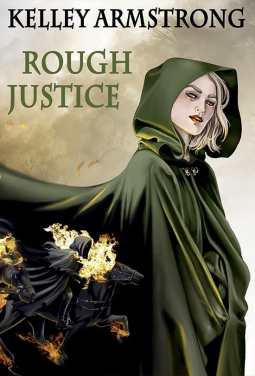
Continuing stories that center on the same cast of characters, advancing their relationships yet complete in themselves, face a number of hurdles. Whether linked short stories, novellas in this case, or entire novels, they must furnish enough backstory and setting to orient the reader. The first episode is in many ways the easiest; everything is new, nothing taken for granted. Often the protagonist explores the world via the plot, taking the reader along. In subsequent stories, the task requires progressively higher levels of finesse to give the reader the necessary history and detail in a smooth, unobtrusive fashion without interrupting the dynamic flow of action. Too much information will becalm the reader in a Sargasso Sea of exposition; too little creates disorientation and puzzlement.
At the same time, each story must stand on its own in terms of plot: inciting event, reversal, tension building to a resolution, and so forth. Not all ends need to be neatly tied up, but the reader should finish with a sense of satisfaction.
Rough Justicesucceeds to a greater or less degree in these areas. Two concepts drive the story: a set of characters, avatars of ancient Welsh figures, who lead the Hunt, giant black red-eyed hounds and all, while wrestling with their previous incarnations and present lives (an attorney, a PI, and an ex-biker, all living just outside present day Chicago); and a very nifty murder mystery, complete with twisty turns, devious motives, and red herrings. PI Olivia (“Mathilda of the Hunt”) is on the brink of ordering the deadly finale to her first Hunt when her qualms allow the condemned man to escape. The Huntsmen claim to have an infallible supernatural method of determining guilt according to their “rough justice,” but Olivia isn’t convinced. She and her lover, attorney Gabriel (Gwynn in the old story) investigate what turns into a double murder/coverup/setup. That part is sneaky enough to please anyone who loves a puzzle.
The problems arise with the way the ancient Welsh myths play out in the lives of Olivia, Gabriel, and Ricky (Arawn). There’s an enormous amount of backstory and lore including how these three learned of their past lives, their roles in the Hunt, history and rules for same, the romantic triangle between Mathilda, Gwynn, and Arawn and how it relates to Olivia, Gabriel, and Ricky (or not). Plus the personal stories, relationships, and dark secrets of the three modern characters. This is where Rough Justice succeeds less well.
A certain amount of this setting and history is of course necessary but much more is presented in ways that paralyze the forward momentum of the pot. Although the story opens with the dramatic Hunt, it’s soon bogged down in backstory and long discussions of why the head Huntsman would set newbie Olivia up with a questionable verdict (and the question of whether the Huntsman is manipulating Olivia is never resolved).
On the other hand, Gabriel’s abusive, now-senile mother is being cared for by two women whose roles and relationships were never clear to me – family, professional caregivers, or fae guardians who strangely know little of Gabriel’s childhood? Therein lies the problem of trying to develop novel-length subplots in novella-sized chunks while reiterating everything that has gone before.
The setting and characters are intriguing enough to interest me in searching out the earlier installments of “Cainsville Tales” and certainly looking out for newer ones, especially if they contain similarly fascinating mysteries, but I can’t help thinking this tale would work better as a single-volume novel.

Published on July 20, 2018 01:00
July 13, 2018
Short Book Reviews: Definitely Not "The Princess Bride"
Kill the Farm Boy, by Kevine Hearne and Delilah S. Dawson, Del Rey
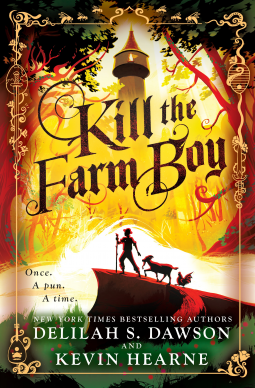
These days I’m on a Kevin Hearne reading spree (see my reviews of A Plague of Giants and The Squirrel on the Train) so I dove into Kill the Farm Boy, discovering to my delight that Hearne’s co-author, Delilah S. Dawson, is none other than another of my recent favorites, as Lila Bowen author of the excellent “The Shadow” series. Delight rapidly gave way to hilarity as this story unfolded, tackling one fantasy trope after another, turning them on their heads and planting petunias between their toes.
The titular farm boy is Worstley, younger brother of Bestley, who had been stabbed in the heart by Lord Ergot (if you don’t know what ergot is, pause now and look it up) for being too handsome. When a malicious pixie named Staph (aureus?) casts a spell to change Worstley into the Chosen One (and gives Gustave the goat the ability to speak, which he does in smart-ass style), it does not set well with The Dark Lord Toby (whose most powerful spell causes baked goods to rain from the sky). Opposing The Dark Lord Toby’s nefarious, yeastly plans are Fia, a 7-foot tall barbarian warrior, and her sweetheart, Argabella, a woman enchanted to be a half-rabbit, who incidentally is the world’s worst bard:
She … sang an improvised song of obfuscation:It’s hard to beat that.
We are not food
No sir Mister Monster
We taste super bad
Oh gods we are not food
Really really really
You gotta believe me
The silliness isn’t restricted to spooks of characters from pose, verse, and film (although familiarity with J. R. R. Tolkien, Lewis Carroll, The Princess Bride, The Wizard of Oz, Grimm’s fairytales, Conan the Barbarian, and Norse mythology, to name a few, enhances the humor).
I found that I couldn’t read too many chapters at a sitting, but the play of tropes, not to mention the puns, kept me coming back for another fun visit to the Lands of Pell.

Published on July 13, 2018 01:00
July 10, 2018
Update on The Laran Gambit

I just finished the first draft of The Laran Gambit, the next Darkover novel. Whew! Now to take a little time off to play and then dive into re-reading it and the first revision (which will include making sure the characters' names and eye colors are consistent, that the same conversation doesn't occur 12 times in as many chapters, that there aren't too many plot idiocies and so forth).
I am majorly proud of myself at the moment.

Published on July 10, 2018 15:22
July 6, 2018
Short Book Reviews: More Steampunk Airship Adventures
By Fire Above, by Robyn Bemis, Tor
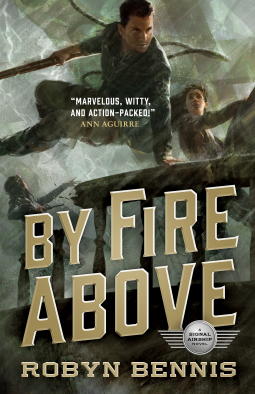
In this sequel to The Guns Above, Robyn Bemis continues the steampunk adventures of a woman airship captain. Once again, Josette Dupree, captain of His Majesty’s Signal Airship Mistral, along with her intrepid crew and not-so-intrepid supercargo, aristocrat Lord Bernat Hinkal, have been given an impossible mission: with glamorous but woefully inadequate repairs to the airship, she is to play a largely ceremonial role at the capital city. None of the real damage the airship sustained in the last batter has been repaired, including the “steamjack” engines. The bags are filled not with expensive, inert luftgas but explosive “flammable air,” a very bad combination with an engine apt to throw off sparks. Needless to say, Josette is unprepared for the courtly intrigues into which she is suddenly propelled (and with which Bernat, who grew up in such a milieu, is happy to reverse roles and become her guide). In the air, conducting a battle in three dimensions, Josette is as cunning as she is courageous. But thrown into the viper’s nest of courtiers or forced to face her own romantic feelings for Bernat’s brother, she finds herself all too fallible.
Josette has no intention of becoming a trophy hero and soon maneuvers to lead a mission to free the border state where her estranged mother (and Bernat’s lover) lives. From there, one mishap after another balloons (excuse the pun) into disaster.
As in the first adventure, I was impressed by the detailed construction of the airships, as well as the scientific (hooray for physics and chemistry!), mathematical, and engineering principles involved, as well as the strategies when battles are fought in three dimensions (up/down as well as side/side and forward/backward). The action sequences were breathtaking. My reservation, as before, pertains to the creation of a political geography so akin to Western Europe that it made no sense to not use the actual nationalities and thereby avoid reader confusion with made-up names and cultures. That reservation aside, I heartily recommend the series and hope to see more Josette’s unfolding stories (and I expect to see her, like Horatio Hornblower, become admiral one day).

Published on July 06, 2018 01:00
June 29, 2018
Short Book Reviews: Amusement Park Urban Fantasy
Tricks for Free by Seanan McGuire (DAW)
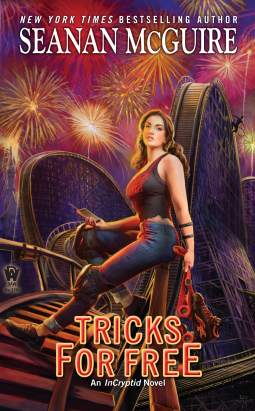
Seanan McGuire’s “InCryptid” series just keeps getting better, her world-building more detailed, and her characters growing and changing as they struggle against inner as well as outer demons. Antimony Price comes from a family of cryptozoologists, dedicated to the study, protection, and sometimes containment of “incryptids,” creatures like Bigfoot, but who live disguised as humans. The last episode, Magic for Nothing, sent Antimony undercover, infiltrating the Covenant of St. George (yes, the dragonslayer), whose aim is the destruction of all incryptids, no matter how benign. While in disguise and investigating a traveling carnival, she met Sam, a trapeze artist whose natural form resembles a graceful simian. Sparrow Hill Road, a related novel, introduced us to the world of road ghosts, crossroads bargains, and route-witches, many of which play crucial roles in this new novel.
Now, at the beginning of Tricks for Free, Antimony is on the run from the Covenant and hiding from her family. As she says:
I never wanted my life to be a wacky sitcom about a human girl and her inhuman roommates struggling to get by at what many people consider to be the second-happiest place in the world.
She’s taken a job working for Lowryland, a not-quite-second-rate Disneyland. Sharing an employer-provided apartment are her friends Fern (a sylf capable of altering her physical density), who enacts one of the many Fairyland princesses, and Megan, a (Pliny’s) gorgon, who in real life is a medical resident. In between the byzantine company politics, trying to stay off the Covenant’s radar and also to not burn down the theme park with her increasingly erratic ability to set fires, Antimony unearths a secret cabal of witches and sorcerers bent upon harvesting the good luck of the patrons to boost their own power. Things go awry as one terribly unlucky accident leads to another. Then Sam shows up, as well as various ghostly aunts, and the plot races right along.
McGuire writes complex, interconnected series in which every (or almost every) volume stands on its own, fast-paced, absorbing, and satisfying. She weaves in backstory and setting with such a deft touch that the reader is neither baffled nor inundated by chunks of indigestible exposition. Although I had read Magic for Nothingand Sparrow Hill Road fairly recently and enjoyed the references, I think Tricks for Free would work just as well as an introduction. So even if you’re new to the delights of the InCryptid and road ghost worlds, dive right in for a great read.

Published on June 29, 2018 01:00
June 26, 2018
Sword and Sorceress 33 Table of Contents
This year I've joined Elisabeth Waters in editing the newest volume of Sword and Sorceress (#33, which will be released in November). The anthology, which contains some amazing stories, is now complete and here's your first sneak peek -- the lineup!
SWORD AND SORCERESS 33 TABLE OF CONTENTS
WRESTLING THE OCEAN
by Pauline J. Alama
HAUNTED BOOK NOOK
by Margaret L. Carter
THE HOOD AND THE WOOD
by Lorie Calkins
SINGING TO STONE
by Catherine Mintz
THE RIVER LADY’S PALE HANDS
by M. P. Ericson
LIN’S HOARD
by Deirdre M. Murphy
THE CITADEL IN THE ICE
by Dave Smeds
ALL IN A NAME
by Jessie D. Eaker
DEATH EVERLASTING
by Jonathan Shipley
BALANCING ACT
by Marella Sands
FIRST ACT OF SAINT BASTARD
by T. R. North
THE FALLEN MAN
by Deborah J. Ross
A FAMILIAR’S PREDICAMENT
by Jane Lindskold
THE SECRET ARMY
by Jennifer Linnea
COMING HOME TO ROOST
by L. S. Patton
FROM THE MOUTHS OF SERPENTS
by Evey Brett
MAGIC WORDS
by Alisa Cohen
CHARMING
by Melissa Mead

SWORD AND SORCERESS 33 TABLE OF CONTENTS
WRESTLING THE OCEAN
by Pauline J. Alama
HAUNTED BOOK NOOK
by Margaret L. Carter
THE HOOD AND THE WOOD
by Lorie Calkins
SINGING TO STONE
by Catherine Mintz
THE RIVER LADY’S PALE HANDS
by M. P. Ericson
LIN’S HOARD
by Deirdre M. Murphy
THE CITADEL IN THE ICE
by Dave Smeds
ALL IN A NAME
by Jessie D. Eaker
DEATH EVERLASTING
by Jonathan Shipley
BALANCING ACT
by Marella Sands
FIRST ACT OF SAINT BASTARD
by T. R. North
THE FALLEN MAN
by Deborah J. Ross
A FAMILIAR’S PREDICAMENT
by Jane Lindskold
THE SECRET ARMY
by Jennifer Linnea
COMING HOME TO ROOST
by L. S. Patton
FROM THE MOUTHS OF SERPENTS
by Evey Brett
MAGIC WORDS
by Alisa Cohen
CHARMING
by Melissa Mead

Published on June 26, 2018 11:48
June 22, 2018
Author Interviews: Juliette Wade
Many of us balance writing, family, day jobs, and taking care of ourselves. Juliette Wade, whose stories have been featured on the covers of magazines like Analog, brings her own inimitable style to the challenge.
Juliette Wade is a rising star in science fiction, writing thoughtful, provocative pieces based in extraordinary insight into culture, language, and personal agency. Of her recent novella, Gardner Dozois wrote:
“The best story in the March Clarkesworld, and one of the best stories published so far this year, is “The Persistence of Blood” by Juliette Wade. … “The Persistence of Blood” is strongly reminiscent of C.J. Cherryh's work, and if you like Cherryh, you're likely to enjoy this story too.”

Deborah J. Ross: When did you know you wanted to be a writer? Juliette Wade: This actually took me a long time. I wrote a lot in elementary and junior high, but then got into nonfiction (i.e. class assignments) and didn't try writing fiction again until I was married and studying for my Ph.D. Maybe it was the fact that I'd been musing on the idea for a secondary world for quite a lot of years by then, but when I started writing, I couldn't stop. The desire to write was so strong and so clear that I knew immediately this was what I was meant to do. It was frightening and wonderful.
DJR: What is your writing process? When do you write? JW: Writing for me is about moments stolen in between running life for myself and my family. The impact of this on my process is that a lot of my work gets done in the form of thinking while I'm doing other things. Then whenever I get a chance, I sit down at the computer and write everything down. It's easier now than it was when my children were first born, but still, a constant challenge. My favorite time to write is when I'm by myself in the house, and that doesn't happen as often as I'd like.
DJR: How would you characterize your fiction? Are you writing to/for a particular audience or audiences? JW: My fiction is as realistic as I can make it - from the perspective of psychology, sociology, linguistics, and anthropology. I am aiming for a wide audience, but hoping particularly to appeal to people who are looking for diversity, intersectionality, and respect of other cultures.
DJR: What writers have been major influences in your work and why? JW: The writer who most influenced me when I was first beginning to write was Ursula K. LeGuin. The language she uses is graceful, and she brings a cultural sensibility to her work that always impressed me. I could see the evidence of her deep thinking about societies and cultures as well as individuals, and try to emulate her in those ways as best I can. In more recent times, I have found inspiration in the works of N.K. Jemisin and Ann Leckie. It's hard for me to pinpoint any one thing about these authors that I admire, because I admire so much about what they do. One thing they are both good at, though, is making sure to keep an intimate emotional connection to characters at the same time that they bring cosmic significance to events and stakes in their stories.
DJR: What is your most current project?JW: My most current project is a novella that just came out in the March 2018 issue of Clarkesworld Magazine. "The Persistence of Blood" takes place in my Varin world, where people live in a complex caste society in underground cities. Lady Selemei is a noblewoman who nearly died giving birth to her fifth child, who takes the revolutionary step of refusing to bear any more children, despite the fact that the noble caste is in decline and expects every woman to have as many children as possible in order to sustain the Race. Her husband is supportive, and together they attempt to change the law to protect more mothers from death in childbirth, but when things go terribly wrong, she's forced to stand on her own and become a unique political voice in her own society.
DJR: What was the inspiration for the project? JW: I had a conversation with Ann Leckie a couple of years ago, and she encouraged me to try writing a novella in the Varin world. I chose to focus on Lady Selemei because it's important to me that Varin stories reflect the kinds of social issues we are dealing with right now in our own world. Selemei is a very grounded person, and a mom, and has to step out beyond what she has known in order to protect herself and her family from government policies that put her life in danger. It should come as no surprise that she ends up having to fight in the political arena, and that this fight turns out to be very difficult.
DJR: What lies ahead for you as a writer?JW: I'm currently working on a sequel to "The Persistence of Blood," which will feature a character from the Imbati servant caste and take on a very different set of social issues. I'm also working with my agent's help to publish a novel of Varin.
DJR: What advice do you have for new and aspiring writers? JW: I guess my advice would be something Lady Selemei believes in, which is to believe in your own gifts and keep persisting, learning as much as you can along the way.
DJR: What do you do when you’re not writing?JW: When I'm not writing, I do lots of different things. I like to work in my garden, and to take long walks and hikes, all of which help me to think. I like to go top-rope climbing in the gym, and to do yoga, because both of these activities help to relax my over-active mind. I work as an English and French teacher, and I work with my family on things like school homework and life in general!
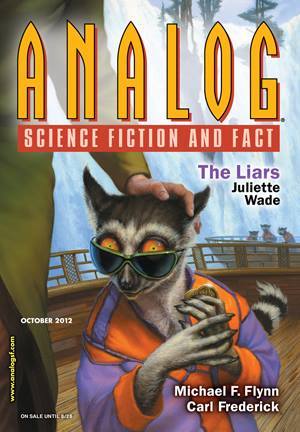 Juliette Wade combined a trip to the Gouffre de Padirac with her academic background in linguistics and anthropology to create the world of Varin, a grand experiment in speculative ethnography. She lives the Bay Area of California with her husband and two children, who support and inspire her. Her fiction has appeared in Clarkesworld, Analog, and Fantasy & Science Fiction. She runs the Dive into Worldbuilding video series and workshop at www.patreon.com/JulietteWade.
Juliette Wade combined a trip to the Gouffre de Padirac with her academic background in linguistics and anthropology to create the world of Varin, a grand experiment in speculative ethnography. She lives the Bay Area of California with her husband and two children, who support and inspire her. Her fiction has appeared in Clarkesworld, Analog, and Fantasy & Science Fiction. She runs the Dive into Worldbuilding video series and workshop at www.patreon.com/JulietteWade.
Published on June 22, 2018 01:00
June 18, 2018
Great Authors Meet Darkover at the Crossroads
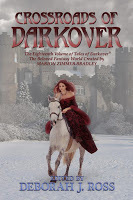 Contributors to Crossroads of Darkover share how they first encountered the world of the Bloody Sun.
Contributors to Crossroads of Darkover share how they first encountered the world of the Bloody Sun.Robin Wayne Bailey: The first Darkover tale I ever read was Darkover Landfall, and I came across it perhaps in an unusual way. At the time, I was working in a bookstore part-time to earn college money, but I was also already a fairly dedicated book collector. Among the books I collected were DAW's yellow-spined paperbacks, which DAW was kind enough to number. I searched these out in new bookstores and used bookstores, determined to own them all, and this is how I came across Darkover Landfall. I'm not sure if I had previously read any of Marion Zimmer Bradley's earlier work, but this book captivated me. I was a sucker for a good "lost colony" story, and this proved one of the best. I remember the day we unpacked that latest DAW shipment and removing this book with its shiny cover and artwork by, I think, Jack Gaughan. It excited me then, and although I drifted away from the series after a time, it continues to excite me.
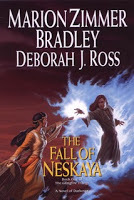 Evey Brett:
Evey Brett:Back in 2002 when I was just out of college, I got a job working retail at a now-extinct Foley's department store in a mall. There was a Waldenbooks right across from the store, so I'd often go get a book and settle down in a comfy chair somewhere in the mall to eat my lunch and read. One day I was looking for a new book and picked up The Fall of Neskaya, and I was hooked. Fortunately for me (and the bookstore) they had several other Darkover novels as well.
I'm a sucker for stories with telepaths and damaged characters. I'd gone through a number of Mercedes Lackey's books, so finding Darkover gave me a whole new world with a sizeable canon to explore. Having just read the back of The Fall of Neskaya, I'd still pick it up to read because it's got everything I want--telepaths, power, gifts, a tormented character with a secret he can't reveal.
Rebecca Fox:As a moody teenage girl with SFnal leanings in the early/mid-1990s, I really had three main reading choices: Pern, Valdemar, or Darkover. Pern I’d found on my own, in a sixth grade language arts reader of all places. My discovery of Valdemar and Darkover (simultaneously) at the age of 14 or 15 and the subsequent loss of at least a week’s worth of sleep while I devoured several books as fast as I could possibly read them I owe to a camp roommate.
My introduction to writing Darkover came via Rosemary Edghill - who is, incidentally, a brilliant human being, a terrific writer, and a truly stellar teacher - who mentored me through my angst-filled and far less than graceful move from Darkest Fanficcia to the Land of Paid Professional Writers and somehow managed not to murder me in the process (it would have been entirely justified, trust me). At any rate, Rosemary invited me to collaborate with her on a story for Stars of Darkover (“Second Contact,” of which I’m still
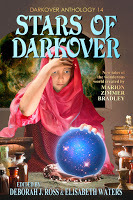 terribly fond) and the rest is history. I remain more grateful than I can really express for the invitation, as well as for patient lessoning in things like how to pace a story and how to edit my own work and more than a few good stiff doses of humility. I wouldn't be here without her, and I hope one of these days I’ll at least get the chance to pay it forward.
terribly fond) and the rest is history. I remain more grateful than I can really express for the invitation, as well as for patient lessoning in things like how to pace a story and how to edit my own work and more than a few good stiff doses of humility. I wouldn't be here without her, and I hope one of these days I’ll at least get the chance to pay it forward.Leslie Fish: I've been a Sci-Fi fan since I was a little kid. I started on comic books, and learned early to recognize the difference the characteristic drawing styles of Steve Ditko, Wally Wood, and Jack Davis. I visited our local corner drugs/convenience/comics store at least once a week, and noticed when they started including magazines and then paperback books. One day I picked up an Ace Double paperback with The Planet Savers on one side and The Sword of Aldones on the other -- and finished them both in a single week, and was forever hooked.
Shariann Lewitt: I think what made [Darkover] very different from all the others—and that kept me with it even as I grew up—was that it felt very real to my own experiences as a nerdy girl who wanted to do something with her life, but had to fight for it. In other worlds, women either were magic users or victims of the patriarchy. On Darkover—a world with the extreme gender roles that my mother insisted were my lot—women who were willing to fight for their dreams could have them. Yes, many of them had laran, but others didn’t. That inspired me and gave me a lot of hope when I was young.
Pat MacEwen: My introduction to science fiction happened in the back of a station wagon on a cross-country road trip when I was 13. An older cousin took pity on me, and gave me a box full of paperbacks to help me pass the time. That’s where I met up with Asimov, Doc Smith, Poul Anderson, Heinlein and more. Once home again, I began to explore the genre, and was delighted to encounter female authors as well, and books with strong female characters and story lines.
Darkover was a rarity then – a complicated world with a long history where women mattered quite as much as men, and which often explored nonbinary questions of sex and gender and family and inheritance, and of course laran. Like most writers, I was something of a misfit in high school, but here was a place where I could see myself fitting in, one way or another. I’m also strongly attracted to moral questions in story-telling and tales of Darkover often focus on intricate problems concerning what’s right and wrong in this setting, compared to Terran mores.
Robin Rowland: I live in the mountainous coast of British Columbia, where we often experience what I like to call “Darkover weather.” This year winter started early, in mid-November. It started with rain, which changed to freezing rain, to wet snow to snow. One day we had 24 hours of heavy snow, followed again by sleet and then rain, and then another 24 hours of heavy snow. One day, I dug out my driveway four times, the next, the sun came out and it was warm and there was a heavy snow melt underway. Now in mid-January, we have had a lot less snow than usual, but over this weekend we had freezing rain that left layers of ice everywhere.
Many years ago Marion Zimmer Bradley told me in the Darkover Suite at Westercon that she was first inspired by the snow in upstate New York and later, in California, by the Sierras. Every science fiction fan brings their own experience to their enjoyment of stories. I grew up in Kitimat and retired here. In a local First Nations (Native Canadian) language Kitimat means “people of the snow. The valley at the end of an 80 kilometre fjord has a unique micro climate. Four times we’ve had a record one day snowfall for all of Canada. The weather can change to warm to wet in a half hour. Winters can see snow up to the roof of a typical Kitimat 1950s two story ranch style house or sometimes so little snow I only use a half bag of snow melter. Summers can either be dreary, overcast and wet or warm to very hot with the occasional drought. So for me, that unique micro climate of the Kitimat valley is perhaps the closest thing on Terra to Darkover.

Published on June 18, 2018 01:00
June 13, 2018
Today's Moment of Serenity
Published on June 13, 2018 01:00
June 11, 2018
A Thousand Ways to Story: Lace and Blade 4 Authors Talk About Writing Process
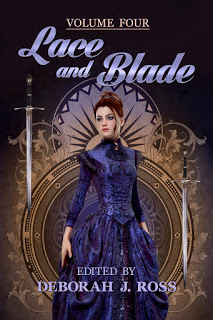 Judith Tarr: [How do I write?] Horribly slowly now, but it still works, after a fashion. I get ideas and prompts from all kinds of places. I keep a file of them, multiple files in fact, and when one really needs to have a story, I pull it out and make notes and brainstorm and throw things together and see what comes of it. I do outline, but it's an ongoing, circular, organic process, which grows and changes as the characters wake up and start talking (or often yelling), and the settings make themselves visible, and the gears of story--the friction, the "what does this character want?" and "what are the stakes here?" questions that move it all forward--start to turn. Sometimes in totally unexpected directions.
Judith Tarr: [How do I write?] Horribly slowly now, but it still works, after a fashion. I get ideas and prompts from all kinds of places. I keep a file of them, multiple files in fact, and when one really needs to have a story, I pull it out and make notes and brainstorm and throw things together and see what comes of it. I do outline, but it's an ongoing, circular, organic process, which grows and changes as the characters wake up and start talking (or often yelling), and the settings make themselves visible, and the gears of story--the friction, the "what does this character want?" and "what are the stakes here?" questions that move it all forward--start to turn. Sometimes in totally unexpected directions.With this story, I had a visual first, a scene viewed from above. Then I became aware of the viewpoint, and the character started telling me the story. I knew what had to happen in the end, but not how to get there, until I started telling the story. The resolution didn't come clear until I wrote the scene. What I thought was going to happen was not what actually happened at all.
Carol Berg: I’m an organic story developer, that is I start with a character in a situation and enough thinking about the world, cultures, and characters to put down the first scene. The act of writing that scene gives me ideas for moving forward in plot, characters, and world development, so that by the time I’m halfway in, I’ve got lots of notes about what needs to happen next. Every day, I read what I wrote the previous day, getting it right enough I can charge forward toward a climax that, so far, has made itself apparent by the time I get there. Revision is my friend and delight!
Marie Brennan:
I am such a night owl. Such a night owl. As I type these words, it's almost 11:30 at night, and this is the warm-up work I'm doing before settling in to put more words on the current story. I'll probably go to bed between 2 and 3 a.m. This has been my habit since college, and I've been lucky that, barring a few summer jobs with very early start times, I've been able to maintain my preferred schedule for basically my entire adult life.
As for the stories themselves, I am much more of a discovery writer than an outliner, though lately I've been working on some collaborative projects where outlining is a necessity. I can do that if I have to, but I prefer when possible to figure out my story as I go along -- that way I stay excited about it, rather than feeling like I'm just filling in the blanks.
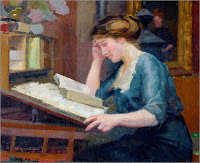
Dave Smeds: At first I wrote to prove I could do it. Next I wrote to earn money. Both motivations, in my view, demanded that I write the best work I could, so in that respect, I have no regrets. But I write now with the awareness that an author of fiction has an obligation to inject meaning into an essentially meaningless universe. That’s our job as human beings. We are creatures of pattern recognition. It’s our chief survival trait. But a fiction writer must do it better than anyone. Hard to do. However, at this point in my life I’ve proven I can write many types of fiction and I’m at a point where I don’t need the money, really, so what keeps me putting the words down on the chance it will move a reader in a way that would not have happened otherwise. As said, hard to do. I try anyway.
My process would drive any other writer nuts, I suspect. The ideas — whether it is for a scene, a character, a setting, a plot, a premise — bubble up and I go with what fascinates me at the moment. I see the whole story as a piece and fill in the pieces almost randomly as if assembling a jigsaw puzzle. I might write the ending first. I might write a little bit that fits two-thirds of the way along. Often I will start at the beginning, but it’s just about unheard of that I proceed from page one to the end in chronological order. I think that’s happened only three or four times in forty-seven years of writing, and only with very short pieces.
Doranna Durgin:
I write what I do because it’s all inside me, and possibly I would explode if I didn’t find a way to let it out. And I also write what I do because authors before me have made me feel the wonder of their worlds, and I want more than anything to share the wonders I feel from my stories, too. And I write because I want to explore and reveal things I think are important—things we’ve forgotten about our world, through alternative lenses.
How my work differs [from others’] as I go about that is, I think, a reflection of how and where I’ve always lived—I’m an environmental ed major and former park naturalist who’s always lived as close to the real world as possible. Once upon a time, that meant a log cabin on a hundred acres of Appalachian mountainside where I interacted with more critters than humans. Since then I’ve immersed myself in the land on SW Virginia farm acreage (and spent my summers sleeping in a wee tent anyway) followed by rural high altitude desert foothills. Always close to my animals—horses and dogs--and training them, an avocation that led me to the current pack of four that includes the most highly performance-titled Beagle breed champion in the nation and two more who are right on his heels. I think this immersion—combined with a neurosensory syndrome—provides a framework for my work that likely differs from other approaches.
Pat MacEwen: I’ve had a checkered career that includes degrees in marine biology and anthropology. I’ve also got a sordid past in forensics and war crimes investigations. So I’m a science and history geek with an abiding interest in how things and people and other creatures work, in how they can all go massively wrong, and how we survive it when they do. I like to use arcane bits of biology, and real events and people, and sometimes my old cases, and then ask questions that never come up in mainstream lit. What if the latest group of refugees in your home town are elves? How do you solve crimes involving magic? How do you, as a woman with strong maternal instincts, deal with an alien race that has no concept of mothers but their children are in peril? What is the right thing to do if your own freedom requires enslaving another species?
Marella Sands:I write fantasy and horror, but the fantasy gets darker all the time. Not sure why, except that I'm pretty happy with my real life, so it's kind of fun to explore the dark recesses of the mind. When I'm not happy, I don't want to write about dark things. My writers group says my horror is different because I don't flinch. So, for what it's worth, that's the feedback I get from those who see my early drafts.
It really depends on what I'm writing. If it's historical, I end up doing a lot (maybe months) of research first. If it's horror, then I might just delve right in because I want to capture the character, setting, and mood that have hit me before I get distracted by the next thing. Then I try to write maybe 2000 words a day for 5-6 days a week. That's not always practical, of course, especially during the semesters when I have papers to grade and classes to prepare for. But you gotta have goals!

Published on June 11, 2018 01:00





